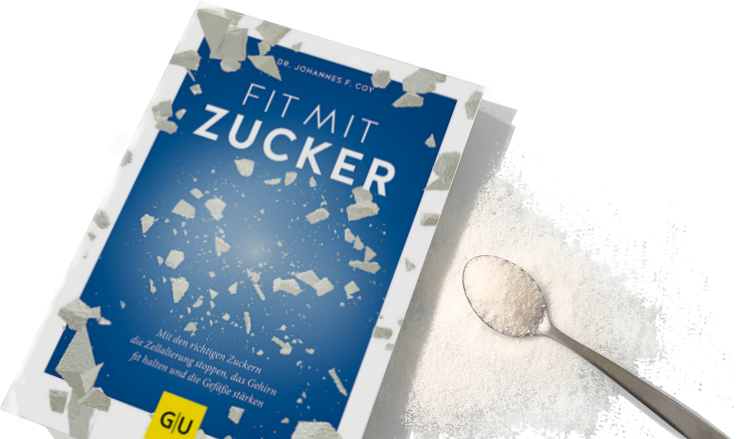Learn more about Dr. Coy and the creation of his sugar solutions.
Dr Johannes Coy is a world-renowned scientist whose research focuses on the health benefits of sugar awareness. Dr Coy has made a number of important genetic discoveries which change our understanding of cancer and nutrition and make him the leading expert on sugars.

Book: Fit with Sugar, by Dr Johannes Coy
Dr Coy has written several books about cancer nutrition. His latest book, Fit with Sugar, is now available. In this book, you’ll discover the evolutionary role of sugar in the human body. Consuming too much conventional sugar isn’t good for our health, but with the right sugars, we can stop cell ageing, keep the brain fit, protect against diseases and switch on fat burning. Find out how you can maintain physical and mental performance using natural low- glycaemic sugars and sugar substitutes. The book includes many delicious recipes for cakes, snacks and desserts, so you can implement a sugar-conscious diet easily and intelligently, without giving up sweet treats.
Buy the book: Cancer-Fighting Diet: Diet and Nutrition Strategies to Help Weaken Cancer Cells and Improve Treatment, by Dr Johannes Coy.
Research & Resources
Mannose-directed nanoparticle delivery systems: enhancing precision and efficacy of drug delivery.
This article reports on the use of mannose functionalisation of nanoparticles for targeted drug delivery in cancer. By decorating nanoparticle surfaces with mannose moieties, researchers exploited mannose-receptor–mediated uptake in tumour or immune cells, achieving improved drug accumulation at tumour sites, reduced off-target toxicity, and enhanced therapeutic efficacy in preclinical models. The study underscores mannose as not just a metabolic agent but also a delivery facilitator in oncologic treatment systems.
Manipulating mannose metabolism as a potential anticancer strategy.
This review article analyses how cancer cells exploit metabolic pathways and how mannose—being the C-2 epimer of glucose—can counteract the “Warburg effect” by entering the glycolytic pathway inefficiently, thereby slowing tumour cell proliferation. When mannose catabolism is compromised in cancer cells (e.g., low MPI activity), mannose leads to a metabolic bottleneck, making tumour cells more chemosensitive and less capable of sustaining growth. The review outlines mechanisms and therapeutic opportunities for targeting mannose metabolism in oncology.
Mannose metabolism reshapes T cell differentiation to enhance antitumour immunity.
This study reveals that mannose metabolism plays a critical role in T-cell function within the tumour microenvironment: diminished mannose metabolism is identified as a hallmark of T-cell dysfunction and exhaustion, whereas enhanced mannose metabolism supports T-cell stemness and effector differentiation. The authors show through single-cell metabolic profiling that boosting mannose flux in T cells improves their anti-tumour activity, suggesting a novel immunometabolic axis that could be targeted to improve cancer immunotherapy.
D-Mannose promotes PD-L1 degradation via AMPK activation and enhances immunotherapy response in TNBC.
This study shows that D-mannose activates AMPK in triple-negative breast cancer cells, leading to accelerated degradation of PD-L1—the key protein tumours use to evade immune detection. By lowering PD-L1 levels, mannose makes cancer cells more responsive to immune-checkpoint therapy, resulting in stronger anti-tumour effects in preclinical models.
D-Mannose suppresses glioma progression via myeloperoxidase-mediated mechanisms.
This study demonstrates that mannose slows glioma progression by supporting myeloperoxidase-driven oxidative mechanisms that inhibit tumour growth. Mannose-treated gliomas show reduced proliferation and improved response in preclinical models.
Mannose Inhibits the Pentose Phosphate Pathway in Colorectal Cancer and Enhances Sensitivity to 5-Fluorouracil Therapy
This research confirms that mannose increases the effectiveness of chemotherapy in colorectal cancer by inhibiting the PPP, reducing NADPH, increasing oxidative stress, and leaving cancer cells more vulnerable to chemotherapeutic agents.
Metabolic clogging of mannose triggers dNTP loss and genomic instability in human cancer cells
This study reveals that excessive mannose leads to metabolic congestion in cancer cells, depleting dNTP pools necessary for DNA replication and repair. The resulting genomic instability weakens tumour survival and highlights a metabolic vulnerability that could be therapeutically exploited.
D-mannose facilitates immunotherapy and radiotherapy of triple-negative breast cancer via degradation of PD-L1.
The authors show that mannose enhances responses to immunotherapy and radiotherapy by promoting the degradation of PD-L1, a protein tumour cells use to evade immune attack. Reducing PD-L1 levels increases tumour sensitivity to immune-mediated destruction and significantly improves therapeutic outcomes.
D-Mannose promotes recovery from experimental colitis by inducing AMPK phosphorylation to stimulate epithelial repair.
This study identifies AMPK activation as a crucial mechanism by which D-mannose promotes intestinal healing. By activating AMPK, mannose enhances epithelial cell repair, improves barrier integrity, and accelerates recovery in colitis models.
Mannose shows antitumour properties against lung cancer via inhibiting proliferation, promoting cisplatin-mediated apoptosis and reducing metastasis
This research shows that mannose suppresses lung cancer progression by slowing cell proliferation, enhancing apoptosis—particularly in combination with cisplatin—and reducing metastatic spread. Mannose disrupts cancer cell metabolism and strengthens the cytotoxic effects of chemotherapy.
Mannose alters gut microbiome, prevents diet-induced obesity, and improves host metabolism
This study finds that chronic mannose intake shifts the gut microbiome toward a healthier composition, helping prevent weight gain and metabolic dysfunction induced by a high-fat diet. Mannose supplementation reduces inflammation, improves glucose tolerance, and reshapes microbial communities in ways that contribute to better overall metabolic health.
Fructose and Mannose in Inborn Errors of Metabolism and Cancer
This review explains how mannose and fructose metabolism intersects with inherited metabolic disorders and cancer biology. It highlights how defects in mannose metabolism affect glycosylation pathways and discusses how tumour cells exploit or become vulnerable to altered mannose flux, pointing to therapeutic opportunities by targeting these sugar pathways.
Mannose impairs tumour growth and enhances chemotherapy
This pivotal study shows that mannose accumulates as mannose-6-phosphate in tumour cells, causing a bottleneck in glycolysis and disrupting energy metabolism. As a result, tumour growth slows, and cancer cells become more susceptible to chemotherapy, especially drugs like cisplatin and doxorubicin. The combined effect significantly enhances treatment outcomes and reduces tumour aggressiveness.
Mannose ameliorates experimental colitis by protecting intestinal barrier integrity.
The authors demonstrate that mannose improves outcomes in experimental colitis by strengthening the gut barrier and reducing inflammatory damage. Mannose restores tight-junction proteins, limits tissue permeability, and reduces pro-inflammatory cytokines, resulting in improved mucosal protection and faster recovery from colitis.
D-mannose is a rapid inducer of ACSS2 to trigger rapid and long-lasting antidepressant responses through augmenting BDNF and TPH2 levels
This study reveals a previously unknown neurological effect of D-mannose: rapid activation of ACSS2, a key enzyme that boosts acetyl-CoA availability in the brain. This activation elevates BDNF and TPH2 levels, improving neuroplasticity and serotonin synthesis. As a result, D-mannose produces both fast-acting and long-lasting antidepressant-like responses in preclinical models, highlighting a new metabolic route for mood regulation.
Mannose inhibits the pentose phosphate pathway in colorectal cancer and enhances sensitivity to 5-fluorouracil therapy
This study shows that mannose interferes with the pentose phosphate pathway (PPP) in colorectal cancer cells, lowering NADPH production and weakening antioxidant defences, which in turn slows tumour growth. By disrupting this metabolic route, mannose makes cancer cells significantly more vulnerable to oxidative stress and enhances the therapeutic impact of 5-fluorouracil, leading to improved chemosensitivity and reduced tumour viability in experimental models.
Mannose: A Sweet Option in the Treatment of Cancer and Inflammation
This review article examines Mannose and its emerging potential in treating cancer and inflammation. The authors highlight how mannose is poorly used by mammalian glycolysis but can accumulate as mannose-6-phosphate, disrupting tumour cell glucose metabolism (especially in cells with low expression of the enzyme mannose phosphate isomerase) and thereby inhibiting growth, enhancing chemotherapy and reducing metastasis. They also review evidence that mannose promotes immune tolerance by generating regulatory T cells and suppresses inflammatory pathways (for example by reducing hyaluronan synthesis), suggesting applications in autoimmune disorders and allergic inflammation. Finally, they caution that although mannose shows promise as a safe dietary-derived molecule, further work is needed to determine effective human doses, mechanisms and long-term safety.
Structural features of sugars that trigger or support conidial germination in the filamentous fungus Aspergillus niger
The asexual spores (conidia) of Aspergillus niger germinate to produce hyphae under appropriate conditions. Germination is initiated by conidial swelling and mobilization of internal carbon and energy stores, followed by polarization and emergence of a hyphal germ tube. The effects of different pyranose sugars, all analogues of d-glucose, on the germination of A. niger conidia were explored, and we define germination as the transition from a dormant conidium into a germling. Within germination, we distinguish two distinct stages, the initial swelling of the conidium and subsequent polarized growth. The stage of conidial swelling requires a germination trigger, which we define as a compound that is sensed by the conidium and which leads to catabolism of d-trehalose and isotropic growth. Sugars that triggered germination and outgrowth included d-glucose, d-mannose, and d-xylose. Sugars that triggered germination but did not support subsequent outgrowth included d-tagatose, d-lyxose, and 2-deoxy-d-glucose. Nontriggering sugars included d-galactose, l-glucose, and d-arabinose. Certain nontriggering sugars, including d-galactose, supported outgrowth if added in the presence of a complementary triggering sugar. This division of functions indicates that sugars are involved in two separate events in germination, triggering and subsequent outgrowth, and the structural features of sugars that support each, both, or none of these events are discussed. We also present data on the uptake of sugars during the germination process and discuss possible mechanisms of triggering in the absence of apparent sugar uptake during the initial swelling of conidia.
Get in touch with Intelligent Sugar
Got a question about Dr Coy’s sugars? Contact info@intelligentsugar.info
If you have a question about a specific health condition, please speak to your doctor.

